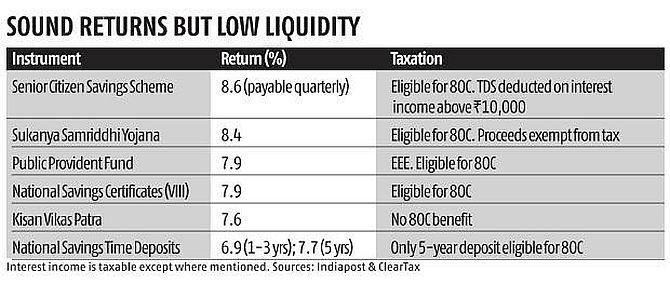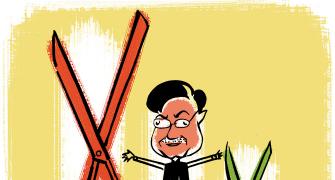Investors should take a longer-term view and only allocate to these instruments after taking a few additional criteria into consideration, says Sarabjeet K Sen.
Illustration: Uttam Ghosh/Rediff.com

Investors in small savings schemes breathed a sigh of relief when the government announced on October 1 that interest rates on these instruments would not be revised for the fourth quarter of the calendar year.
With the economy witnessing a slowdown, and the stock markets also turning volatile, many investors are looking for alternative avenues to park their savings.
Small savings schemes, with their sovereign guarantee, have emerged as a viable alternative.
Investments in small savings schemes have surged 37 per cent between April and July 2019, as investors sought refuge in these guaranteed-return products in the current environment.
With the returns of equity mutual funds having slumped, the returns of these schemes may appear more attractive at present.
Nonetheless, investors should take a longer-term view and only allocate to these instruments after taking a few additional criteria into consideration.
Tenure must fit investment horizon
The small savings schemes bouquet offers exposure to a variety of tenures.
You may invest in post office time deposits for one, two, three and five years.
National Savings Certificate (NSC) is issued for five years and Kisan Vikas Patra (KVP) for 113 months.
Public Provident Fund (PPF) has a tenure of 15 years and Sukanya Samriddhi Yojana (SSY) allows first withdrawal only when the girl child turns 18.
Those who have a short-term tenure of, say, around one to three years, may look at the fixed deposits of public-sector banks.
These offer better rates of return and come with a similar level of risk.
Those with a longer tenure of above five years should look at a mix of equities and fixed-income instruments, including small savings schemes.
Once the investment horizon exceeds five years, the bulk of your portfolio should consist of equities.
Over the long term, the impact of the volatility associated with equities goes down and returns improve.
"When you are investing for the long term, consider investing in inflation-beating instruments that can deliver higher returns. A portfolio comprised of inflation-beating assets like equities and equity mutual funds, and small savings instruments should be adopted, based on the investor's risk profile," says Santosh Joseph, founder and managing partner, Germinate Wealth Solutions.
Even when saving for a goal that is 20 years away, most investors don't want a 100 per cent allocation to equities.
They are more comfortable with an 80:20 or 75:25 allocation to equities and debt.
Investors may opt for small savings schemes like PPF in the fixed-income component of such portfolios.

Take into account your liquidity needs
Small saving schemes score low on liquidity, when compared to options like stocks and mutual funds, which can be sold quickly.
However, some provision for partial withdrawal does exist.
In PPF, for instance, you can withdraw money after five years.
"Small savings schemes are fairly illiquid. Invest in these instruments only if you are comfortable with their lock-in period," says Rajesh Cheruvu, chief investment officer, Validus Wealth.
Beware the rate-reset clause
Going by the recommendations of the Shyamala Gopinath panel, the government reviews the interest rates on small savings schemes every quarter.
If the rates are revised downward, then the rate payable on existing as well as future investments goes down in the case of PPF and SSY.
Interest rates have been on a downward spiral.
On June 28, the government had cut interest rates by 10 basis points across small savings products.
"Downward revision of rates is the biggest risk in these products. The PPF rate, at 7.90 per cent, is currently at a multi-decade low. It could go down even further," says Joseph.
While there is a burden on the government to manage investors' expectations, it cannot keep interest rates high in a scenario when they are falling globally, as doing so would hurt its finances.
Some instruments are tax-exempt
The interest income from most small savings schemes is clubbed to the income of the recipient and taxed at the marginal rate, except in the case of PPF and SSY.
Interest income from them are tax-exempt.
Due to the tax provisions, many individuals in the 30 per cent tax bracket frown at the thought of investing in small saving schemes, barring PPF.
But many of these products make sense for individuals in the lower tax brackets.
Enjoy tax benefits
Deduction of up to Rs 1.5 lakh is available under Section 80C of the Income-Tax Act.
PPF, SSY, etc qualify for Section 80C benefit (see table above).
The only issue is whether the investor will be able to actually enjoy this benefit, since so many other instruments are also eligible.
Who should invest? PPF, which enjoys EEE (exempt-exempt-exempt) tax status, is a very good product within the small savings bouquet.
Those (including investors in the higher tax brackets) building long-term portfolios for goals such as retirement, children's education and marriage, etc may use it for their fixed-income allocation.
The other two products that offer attractive returns are targeted at specific users.
The Senior Citizens Savings Scheme, with a return of 8.6 per cent, may be used by the retired to derive a regular income.
Remember that interest is paid out every quarter (and not every month).
SSY, with an annual return of 8.4 per cent, is another good option for those saving for their girl child's education or marriage.
As for the other instruments, compare post-tax return with the other fixed-income options available (bank fixed deposits, debt funds, etc) before deciding to invest.
Finally, invest in small savings schemes after factoring in your risk profile, investment horizon and goals.
"Investors who are looking for debt allocation and are comfortable locking in their money for the required time period may consider these schemes," he says.
Joseph warns against concentration risk.
"These instruments should not be the only ones in your portfolio. Returns are prone to revision and many of them may barely beat inflation over the long term," he says.










